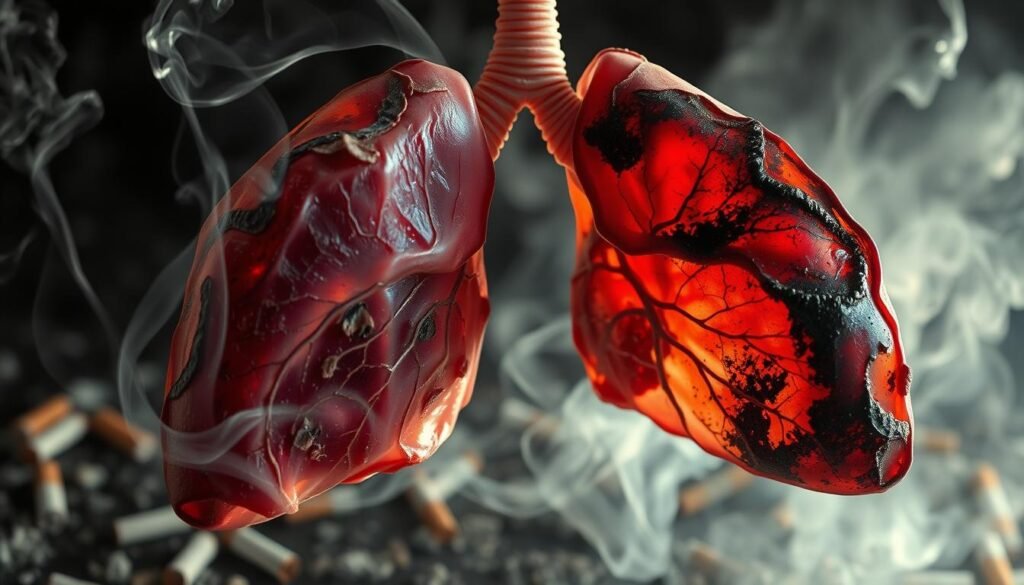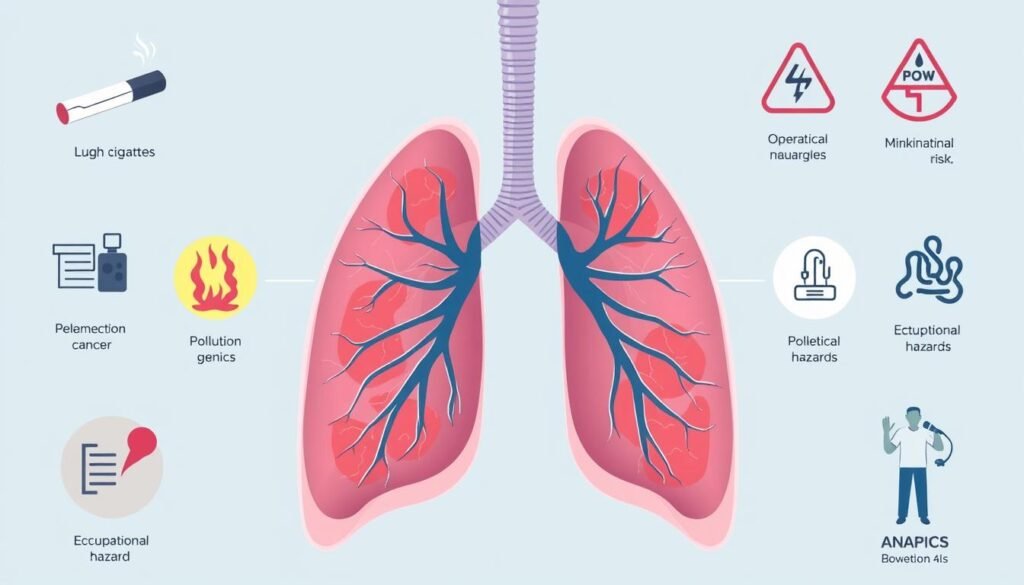Nearly 80% of lung cancer cases in over 169,000 ever smokers are due to smoking. This makes it the top cause of cancer deaths in the United States. Knowing the key risk factors for lung cancer is crucial. It helps not just doctors, but also people wanting to make smart health decisions.
This article gives a thorough look at the factors linked to lung cancer. It covers changeable risks like smoking habits, and fixed factors like genes and family history. With lung cancer being a major concern in public health, knowing these risk factors is key. It helps in preventing the disease and spotting it early.
Key Takeaways
- Smoking remains the primary risk factor for lung cancer.
- Several predictive models assess lung cancer risk with varying accuracy.
- Occupational exposures contribute significantly to lung cancer incidence.
- Genetic and family history play important roles in individual risk factors.
- Environmental factors, including air pollution, can increase risk.
- Understanding these factors aids in making proactive health choices.
Understanding Lung Cancer Risk Factors
Lung cancer is a leading type of cancer worldwide, affected by different risk factors. Knowing these factors allows people to understand their risk of getting the disease. It’s important to know what a risk factor is. A risk factor is something about you or something you’re exposed to that can increase your chance of getting a disease, like lung cancer.
Definition of Risk Factors
When it comes to lung cancer, the most common risk factors are:
- Smoking, which causes about 80% of lung cancer deaths.
- Exposure to radon gas, the second biggest cause of lung cancer, especially if you don’t smoke.
- Occupational hazards, such as asbestos and various inhaled chemicals, also raise the risk.
Impact of Risk Factors on Lung Cancer
The effect of risk factors on lung cancer is complex. People who smoke and are exposed to harmful chemicals face a higher risk. If you’ve been exposed to asbestos, you’re much more likely to die from lung cancer. There’s also research showing that arsenic in drinking water may increase lung cancer risk, highlighting the effect of location.
Having a family history of lung cancer raises your risk too, as do certain personal health issues. For example, if you’ve had radiation treatment to the lungs before. Even what you eat can play a role; beta-carotene supplements could be risky for smokers. Plus, city air pollution slightly increases lung cancer risk, showing how varied the risk factors are.
In short, lung cancer risks come from genes, the environment, and your lifestyle. Understanding these risks can help increase awareness. This could improve how we prevent and manage this serious illness.
Smoking History as a Primary Risk Factor
Smoking history is a major factor in lung cancer risk. Around 87% of lung cancer deaths in the U.S. are linked to smoking. Globally, smoking causes 1.69 million lung cancer deaths each year. Both current and former smokers, especially heavy smokers, face high risks.
Statistics on Smoking and Lung Cancer Rates
Longer smoking histories lead to higher lung cancer rates. For current smokers, the incidence is about 1.97 cases per 1,000 person-years. This number drops to 1.61 for former smokers, but it’s still much higher than the 0.26 for those who never smoked. The risk of lung cancer remains high up to 15 years after quitting, with 40.8% of cases occurring then. Heavy former smokers have a notably elevated risk, as shown in research. To understand more about these risks, lung cancer statistics can offer deep insights.
Effects of Cigar and Pipe Smoking
Cigar and pipe smoking are often viewed as safer than cigarettes, but this is a misconception. They significantly increase lung cancer risk as well. Research shows that both can lead to forms of lung cancer, like SqCC and SCLC. Recognizing the risks of all smoking types is crucial. Those interested in how chronic lung diseases and lung cancer connect can learn more from an overview of COPD symptoms.

Risk Factors to Consider in Lung Cancer Calculations
Lung cancer calculations need a close look at different risk factors. Risk assessment models have been created to help with this. They consider things like smoking history, genes, and where someone has lived or worked. These models help find who might get lung cancer. They also help in deciding who needs to be checked for it early.
Different Risk Assessment Models
Risk assessment models for lung cancer use information from large studies. They examine personal and environmental factors closely. The models look at:
- Smoking status, a big cause of lung cancer. It’s behind 80% to 90% of lung cancer deaths in the U.S.
- Age, since your odds go up as you get older.
- Occupational exposures to dangerous stuff like asbestos and formaldehyde.
- Genetic markers that might show a family risk for lung cancer.
Doctors use these models to make individualized risk profiles. This means they can match screening and prevention to each person. This approach tries to cut down the number of lung cancer cases and deaths.
Importance of Individualized Risk Profiles
Making individualized risk profiles is key. It helps spot those at high risk. It also guides how to keep them safe. Knowing a person’s health history, family background, and lifestyle helps guess lung cancer risk better. For example:
| Risk Factor | Impact on Lung Cancer Risk |
|---|---|
| Smoking | 15-30 times greater risk than for non-smokers |
| Radon Exposure | Second biggest cause of lung cancer; causes 21,000 deaths a year |
| Family History | Doubles your risk if close family members have had lung cancer |
| COPD | 2-4 times more likely to get lung cancer than without COPD |
This deep look helps doctors push for early checks. This can change how well patients do. For more on stopping lung cancer, go to cancer prevention recommendations.

Occupational Exposure and Its Consequences
Many jobs carry the risk of lung cancer due to contact with harmful substances. Workers in fields like construction, manufacturing, and transportation are often exposed to carcinogens. Knowing about these hazards is crucial for keeping workers safe.
Common Carcinogens in the Workplace
Workplaces are filled with substances that can cause serious health problems. Here are some of the main ones:
- Asbestos: This is known to greatly increase the risk of lung cancer, especially in shipyard jobs.
- Chromium: It is linked with a higher chance of getting lung cancer.
- Mineral oils: Being exposed to these oils can lead to lung disease and other health problems.
- Molybdenum: Recent research has shown a strong link between this and lung cancer.
Asbestos and its Relation to Lung Cancer
Asbestos is a major concern, particularly for those working in risky areas. People working in producing transport equipment and metal items are at a greater risk. Studies show shipyard workers and welders have higher chances of getting lung cancer. Smoking increases this risk even more.
The Role of Family History in Lung Cancer Risk
Family history greatly affects lung cancer risk. Studies show that having a first-degree relative with lung cancer increases one’s risk by 1.51 times. This is true even when considering smoking habits and other factors.
This highlights why knowing your family history is crucial in understanding lung cancer risks.
Genetic Factors Contributing to Lung Cancer
Genetics play a key role in lung cancer in families with a history of the disease. The risk is highest when a sibling has lung cancer, with an odds ratio of 1.82. Such genetic links make environmental factors even more dangerous, adding to an individual’s risk.
Shared Environmental Influences Among Families
Environmental factors also raise lung cancer risks in families. Living in the same environment, especially with tobacco smoke, adds to the risk. Those in families with lung cancer history face similar risks from carcinogens like radon. This is true for people who have never smoked, with a familial history raising the odds ratio to 1.25.

| Family Member | Odds Ratio (OR) | Confidence Interval (95% CI) |
|---|---|---|
| Any Family Member | 1.57 | 1.25–1.98 |
| Father | 1.41 | N/A |
| Mother | 2.14 | N/A |
| Sibling | 1.53 | N/A |
| Chronic Bronchitis | 1.49 | 1.23–1.80 |
| Pneumonia | 0.73 | 0.61–0.87 |
Impact of Air Pollution on Lung Cancer
Air pollution is a major health issue, especially for lung cancer. Many pollutants increase the risk. This shows how environmental factors play a big role in cancer growth. Every day, people breathe in about 10,000 liters of air. This exposes them to many cancer-causing agents, raising their lung cancer risk.
Types of Air Pollutants Linked to Cancer
Many air pollutants are linked to lung cancer. Particulate matter, diesel exhaust, and certain heavy metals like arsenic and nickel are some. These are known to be harmful. The International Agency for Research on Cancer calls air pollution a top-level carcinogen. It’s important for everyone to know and take action.
Urban Areas vs. Rural Areas: Risk Variations
Air quality differences between the city and countryside affect lung cancer numbers. Cities have more pollution from cars and factories. People living in cities have a 63% higher chance of getting lung cancer than those in the countryside. This is due to more pollution. Fighting air pollution is key to lower these risks and make our health better.
| Pollutant | Associated Risk Factor | Source |
|---|---|---|
| Particulate Matter (PM2.5) | Significantly increased lung cancer risk | Vehicle emissions, industrial processes |
| Diesel Exhaust | Known carcinogen | Trucks, buses, and some cars |
| Polycyclic Aromatic Hydrocarbons | Linked to lung cancer | Burning of organic matter |
| Heavy Metals (Arsenic, Nickel, Chromium) | Contributing to lung cancer development | Industrial waste, mining |
Radon Exposure: An Invisible Threat
Radon is a colorless and odorless gas coming from uranium decay in soil and rocks. It builds up in places like home basements. This gas can increase lung cancer risk, making it the second leading cause in the U.S., particularly for non-smokers. Knowing how radon gets into homes and testing for it is crucial.
Understanding Radon and Its Health Risks
Being around radon for a long time can greatly raise the chances of lung cancer. Research shows that 10-25% of lung cancers not caused by smoking are due to radon. In South Korea, about 5% of lung cancer cases might be linked to radon. This reveals a growing public health issue. So, it’s vital for people to test their homes for radon regularly.
There are ways to lower radon that cost between $2000 and $4000. Techniques like sub-soil depressurization reduce radon levels effectively. Radon test kits are a simple tool for checking levels at home and cost $30 to $60. But, for thorough testing, hiring a certified radon expert is best. They offer precise tests and solutions.
Knowing the dangers of radon is key. Many overlook radon’s role in lung cancer. Raising awareness about indoor radon can push for better prevention.
Safe air is good for lung health and overall well-being.
To fight radon’s harmful effects, public health efforts and personal steps must join forces. A culture of testing and mitigation can cut lung cancer risks and save lives. Homeowners should make radon safety a top concern.
Check out this resource for more on how radon affects lung cancer, risks, and what to do.
Other Significant Risk Factors
Many factors besides smoking can raise the risk of lung cancer. These include chronic lung diseases and what we eat. Understanding them helps in lowering the dangers linked to lung cancer.
Chronic Lung Diseases and Their Impact
Chronic lung illnesses like COPD and emphysema make lung cancer more likely. They harm lung tissue and make breathing hard. This can lead to cancers growing more easily. Studies show that people with these chronic lung issues have a higher risk of lung cancer. Their risk can be up to twice as high as for those without these diseases.
Dietary Influences on Lung Cancer Risk
What you eat can influence your lung cancer risk too. Certain foods can make this risk higher or lower. For example, not getting enough antioxidants like vitamins A, C, and E can change your lung cancer risk. Eating a diet full of nutrients can help protect against lung cancer. It shows how important your diet is for your lung health.
Conclusion
It’s vital to understand lung cancer’s risk factors to promote effective prevention and early detection. Smoking is the biggest risk. It causes about 85% of lung cancer deaths each year. Other dangers include workplace hazards, air pollution, and genetics. Together, they make it crucial to look at everything that could increase risk.
People with multiple risks should be extra careful, even if they’ve never smoked. For instance, non-smoking women with lung cancer in their family history and breathing problems face similar risks as smokers. This shows why knowing about lung cancer risks matters. It helps people take preventive steps and go for screenings. This can lower the rates of lung cancer illness and death.
We need more research and public health efforts to fight lung cancer. Health workers can then use improved risk calculators and education to find those at higher risk easier. By doing this, we might lessen lung cancer’s effect in communities throughout America.